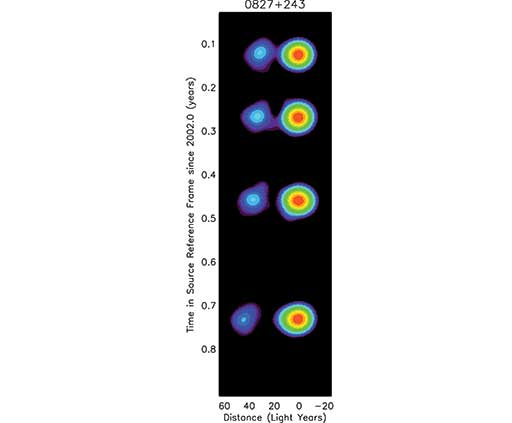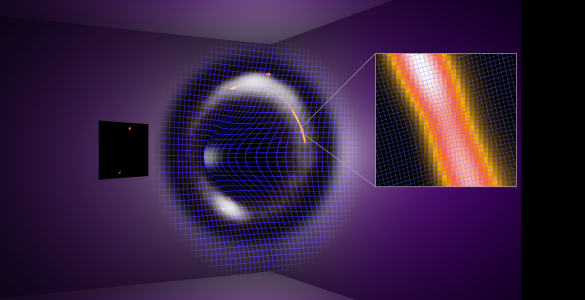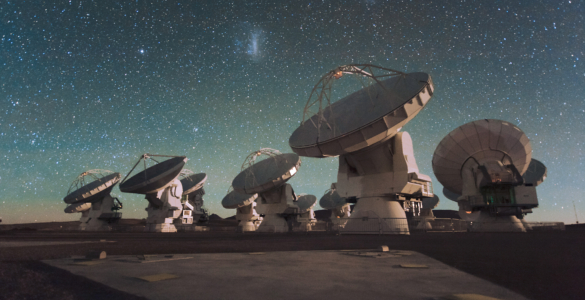Astronomers using the National Science Foundation’s Very Long Baseline Array (VLBA) have discovered jets of plasma blasted from the cores of distant galaxies at speeds within one-tenth of one percent of the speed of light, placing these plasma jets among the fastest objects yet seen in the Universe.
“This tells us that the physical processes at the cores of these galaxies, called blazars, are extremely energetic and are capable of propelling matter very close to the absolute cosmic speed limit,” said Glenn Piner of Whittier College in Whittier, California. Piner, who worked on the project with student Dipesh Bhattari, also of Whittier College, Philip Edwards of the Japan Aerospace Exploration Agency, and Dayton Jones of NASA’s Jet Propulsion Laboratory, presented their findings to the American Astronomical Society’s meeting in San Diego, California.
According to Einstein’s Special Theory of Relativity, no object with mass can be accelerated to the speed of light. To get even close to the speed of light requires enormous amounts of energy. “For example, to accelerate a bowling ball to the speed newly measured in these blazars would require all the energy produced in the world for an entire week,” Piner said, “and the blobs of plasma in these jets are at least as massive as a large planet”.
Blazars are active galactic nuclei — energetic regions surrounding massive black holes at the centers of galaxies. Material being drawn into the black hole forms a spinning disk called an accretion disk. Powerful jets of charged particles are ejected at high speeds along the poles of accretion disks. When these jets happen to be aimed nearly toward the Earth, the objects are called blazars.
Taking advantage of the extremely sharp radio “vision” of the continent-wide VLBA, the scientists tracked individual features in the jets of three blazars at distances from Earth ranging from 7.3 to 9 billion light-years. A Boston University team led by Svetlana Jorstad earlier had identified the three blazars as having potentially very high jet speeds based on VLBA observations in the mid-1990s. Piner and his colleagues observed the blazars again in 2002 and 2003 with much longer observations, and were able to confirm the high-speed motions in the faint blazar jets.
Their measurements showed that features in the blazar jets were moving at apparent speeds more than 25 times greater than that of light. This phenomenon, called superluminal motion, is not real, but rather is an illusion caused by the fact that the material in the jet is moving at nearly the speed of light almost directly toward the observer. Because the jet features are moving toward Earth at almost the same speed as the radio waves they emit, they can appear to move across the sky at faster-than-light speeds. Scientists can correct for this geometrical effect to calculate a lower limit to the true speed of the features.
“We typically see apparent speeds in blazar jets that are about five times the speed of light, and that corresponds to a true speed of more than 98 percent of light speed,” Piner said. “Now, based on independent confirmation by two groups of astronomers, we see these three blazars with apparent speeds greater than 25 times that of light,” Piner added. That apparent speed, the scientists said, corresponds to a true speed of greater than 99.9 percent of light speed, which is 186,282 miles per second.
Based on other properties of blazars, the scientists believe that their interpretation of the data is accurate and that they have measured the extremely fast speeds in the three blazar jets. However, “we do have to be somewhat careful in interpreting these results, because it is possible that the observed motions represent the motion of some propagating disturbance in the plasma rather than the plasma itself, in the same way that a water wave can move across the surface of the ocean without physically transporting the water,” Piner said.
The VLBA is a system of ten radio-telescope antennas, each with a dish 25 meters (82 feet) in diameter and weighing 240 tons. From Mauna Kea on the Big Island of Hawaii to St. Croix in the U.S. Virgin Islands, the VLBA spans more than 5,000 miles, providing astronomers with the sharpest vision of any telescope on Earth or in space. Dedicated in 1993, the VLBA has an ability to see fine detail equivalent to being able to stand in New York and read a newspaper in Los Angeles. The VLBA is operated from the National Radio Astronomy Observatory’s Array Operations Center in Socorro, NM.
The research was supported by the National Science Foundation and the Research Corporation. Part of the research was carried out at the Jet Propulsion Laboratory, California Institute of Technology, under contract with the National Aeronautics and Space Administration. The National Radio Astronomy Observatory is a facility of the National Science Foundation, operated under cooperative agreement by Associated Universities, Inc.
Contact:
Dave Finley, NRAO
(505) 835-7302
dfinley@nrao.edu
Dana Rakoczy, Whittier College
562-907-4200 x4974
drakoczy@whittier.edu















